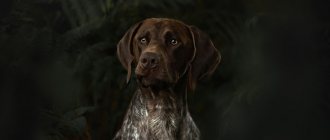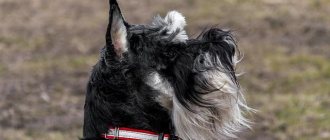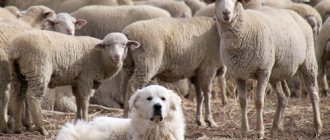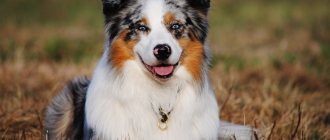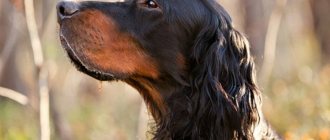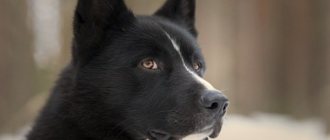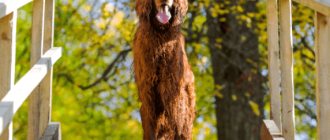Dossier
Adult height: males 65-70 cm, females 60-65 cm. Weight: 20-25 kg. Characteristic color: black-mottled, orange-mottled, yellow-mottled, brown-mottled or tricolor. Coat length: longhaired. Life expectancy: 10-14 years. Advantages of the breed: Hardy, unpretentious, active, friendly. An excellent hunter. Difficulties of the breed: Does not tolerate long stays in an apartment and loneliness. Requires long walks. Average price: 600 – 1500 $. Classification: large breed, hunting.
History of the origin of the breed
In the 19th century, scientists from the southern part of England, after lengthy attempts, were finally able to develop a breed that would catch game birds. The ancestors of this breed are considered to be the French and Spanish pointer and various spaniels. English setters are sometimes called "Laverk setters" in honor of the scientist.
And the word “setter” means the position this dog takes before catching the game. Today this breed is very popular in various shows and is still used to help with hunting. Setters are very friendly, affectionate and quiet and can be an excellent choice for a family.
Frequent illnesses and problems
To avoid problems with the health of setter puppies, it is recommended to take the dogs to the veterinarian. At the age of 2 months, the puppy receives its first vaccination; treatment against parasites and worms is mandatory. Be aware of a serious problem for the breed: parvovirus, which can lead to the death of your pet. Setters are prone to the following diseases:
- hip dysplasia;
- inflammatory process with the release of pus in the uterus of bitches;
- paralysis;
- oncology;
- dilatation of the esophagus;
- deafness (often congenital);
- allergy;
- eversion of the eyelid;
- volvulus;
- retinal atrophy;
- dermatitis;
- otitis;
- epilepsy attacks.
It is important to maintain your pet's immunity to avoid the occurrence of all these diseases.
The English Setter is a wonderful companion, a reliable friend and an excellent hunter. He will gladly support his owner's passion for hunting, swimming, and cycling. He has a submissive and affectionate disposition that will allow him to make friends with all family members. Its beautiful appearance will not leave anyone indifferent - you will definitely fall in love with this elegant and proud dog!
The homeland of the French poodle is not France.
The homeland of the poodle is Germany. The name "poodle" is derived from the German "pudel" or "pudelhund" and means "splashing dog." The world-famous haircut of poodles appeared when hunters cut their hair for ease of swimming, leaving only a little fur to keep warm.
Dogs can detect cancer and other diseases
If a person has cancer, diabetes, or epilepsy, his dog may be the first to know about it. Research has shown that dogs can be trained to detect cancer in a specific organ, such as the lung, breast, skin, bladder and prostate. Scientists believe that dogs can smell even the faintest smell of malignant tumors.
Dog nose prints are as unique as human fingerprints.
Dog nose prints are unique, so they are used to identify an animal, just like fingerprints are used to identify a person. Criminologists often take advantage of this circumstance when investigating crimes involving animals and their owners.
What is the breed for?
Since the breed has a strong innate hunter's instinct, it is used in hunting both waterfowl game (ducks, teal, etc.) and partridges, hares, pheasants and quails. But it is not necessary to use this breed for hunting.
In addition, they can become a good friend for the owner. In this case, the dog will need long walks. English Setters become very attached to their owner and need a lot of communication, showing themselves to be gentle and kind.
A Dog's Unique Trait
From English, “setter” is translated as “crouching”. The breed received this name due to its unusual manner of movement. When running, dogs push off the ground by flexing their hind limbs. For a few moments they assume a sitting position. Their movement resembles constant squats, for this reason the dogs are nicknamed setters.
According to another version, the name of the breed comes from the English word “set” - “to set”. When the pet notices prey, it stands up, showing the owner the location of the game.
A unique feature of the animals is their unusual hunting behavior. When the pet smells game, it begins to move softly and slowly so as not to scare away the prey. As the aroma intensifies, the dogs' movements become more graceful and cautious.
Description of the nature of the breed
The character of the English Setter breed is described as follows:
- friendly;
- soft;
- communicative;
- tied to the owner;
- calm;
- quiet;
- balanced.
They require a lot of human attention, but give it in return. They behave calmly and not aggressively with strangers. They love to play with children if they treat the dog well . Known for their ability to warn of danger. They are good watchdogs, so you should listen to their reactions. But setters also calm down easily if you tell them about it.
In addition to human company, they love to communicate with other dogs. They are calm towards other pets in the house, be it a cat or any other small animal. As puppies, they are more active than as adults. They love to run, jump and dig.
Character and temperament
The English Setter is a lively, energetic dog.
Undoubted advantages :
- delicacy;
- practically does not bark;
- kind nurse;
- intellectual;
- cheerful;
- friendly.
Minuses:
- Poor watchman and not suitable for home security;
- Without proper physical activity or work, the dog will damage the furniture in the apartment.
How to choose a puppy
To choose the right purebred English Setter puppy and not be disappointed (if you are interested in exhibitions and similar events), you should follow several rules. First, get a puppy from specialized nurseries with the appropriate documentation or from a trusted breeder. The choice should start by meeting the parents .
If you are happy with everything, you should get to know the puppies better. Find out how many puppies were in the litter with defects (color, eye color, deafness). If possible, ask for photos of adult puppies from a previous litter.
It is recommended to observe the puppies you like for at least an hour. Pay attention to activity, appetite and gait. Analyze how they play. Check your eyes. The standard of the English Setter is a long and sharp muzzle, large almond-shaped brown eyes, downturned ears and a tail curved at the tip. The coat can be either wavy or straight, but the color must have small specks.
Health
The average lifespan of an English Setter is 12 years.
In order for your pet to get sick less often, it is important to vaccinate on time and give anti-worm medications. It is also advisable to visit the veterinary clinic with your dog annually for tests, x-ray examinations and preventive examinations.
The owner of an English Setter should know that representatives of this breed are predisposed to the following diseases:
- Bloating - a balanced diet and a diet tailored to all the specific characteristics of the English Setter will help avoid this problem.
- Blindness is congenital, hereditary.
- Joint dysplasia is a hereditary disease that can be caused by puppies and young animals running up stairs or jumping high. The disease is treated both surgically and with medication.
- Growth disturbance - occurs due to improper nutrition.
- Allergic reactions are often food related.
Care and maintenance
Content
A good option for keeping an English Setter would be a private home. In this case, the dog will be able to run a lot and expend its energy. But under no circumstances should such a dog be kept in an enclosure or left outside, since they have no undercoat and are freezing. Keeping in an apartment is possible if the animal is given a lot of attention and takes several walks a day with active games.
Note! The long absence of the owner from home can have a very negative impact on the animal’s condition, since setters are very attached to people.
Walk
First of all, English Setters are recommended for people who lead an active lifestyle. Others will find it difficult with them, since the dog has a bright temperament and high activity. They require long daily walks and exercise.
Wool
It is worth remembering that this is not a short-haired dog. Therefore, you need to pay a lot of attention to caring for your pet’s coat. Regular combing and brushing twice a week is a must, as is clipping and grooming as needed.
Ears, eyes, claws
Excess hair should also be trimmed on the dog’s ears. The ears should be inspected and cleaned regularly, as accumulated dirt can lead to otitis media. The eyes must be washed regularly, and in case of inflammation, special medications should be applied. In most cases, the claws wear down during walks, but if this is necessary, they need to be trimmed.
Bathing
It is recommended to bathe English Setters once every 4-6 weeks to keep their coat in good condition. Dogs love to swim, so they will not cause problems in this matter. The main thing is to choose the right shampoo that suits their coat type .
English Setter
Maria Sotskaya
From the standard: Color: black-speckled (blue-belton), brown-speckled (liver-belton), orange-speckled (orange-belton), yellow-speckled (lemon-belton) and tricolor (tri-color, i.e. black - speckled on the saddle and red-speckled on the tan, liver-belton on the saddle and orange-belton on the tan). A color without large spots on the body is desirable.
The main color alleles: ay - determines the development of the sable color; it is absent in the breed. at - determines the development of tan color, present in the vast majority of representatives of the breed. B - causes the synthesis of black eumelanin, is present in dogs of all colors, except brown-mottled (coffee-mottled), brown and tan and red dogs with a light nose. b - determines the synthesis of brown eumelanin, present in dogs of brown, brown-tan and light red color of the bbee genotype. C - determines the full development of color in accordance with its formula, is present in all representatives of the breed. cch - blocks the synthesis of pheomelanin in the hair, is absent in the gene pool of the breed. D - determines the development of color of full intensity, present in all representatives of the breed. d - causes the development of a weakened color; it is absent in the gene pool of the breed. Em - causes a dark mask, is absent in the gene pool of the breed. E - determines the distribution of eumelanin throughout the dog’s body, present in all representatives of the ginger breed. e - does not allow eumelanin to spread throughout the dog’s body, causing the development of red-mottled colors. K - determines the continuous distribution of eumelanin throughout the hair and body of the dog. Present in all black-mottled, brown-mottled and many red-mottled setters. k - allows the development of a tan color, present in all tricolor setters. S —determines the development of a solid color without white spots; it is absent in the breed. s - causes the development of white spotting and is present in all representatives of the breed. sw - causes an extreme degree of spotting, can be noted in almost white dogs and dogs with individual small colored spots. T - causes the development of markings on white areas, present in almost all representatives of the breed. t - prevents the development of specks on white areas.
All English setters have a speckled color, this is reflected in another popular name for the breed - “speckled setter”.
Speckled color Speckled color is a color in which, against the background of white spots, thick specks of the color of the main color are formed - the so-called teak mottled. The presence of markings is initiated by the dominant T . The spots tend to appear and become more intense with age. In setter puppies it is practically absent, sometimes they appear almost white with isolated dark spots, but with age the markings appear and thicken. In some cases, individual specks practically merge with each other, creating the illusion of a continuous spot. This pattern is sometimes observed on the dog’s limbs. As a result, the spotted dog appears to have dark legs, which does not correspond to the developmental patterns of white spotting.
Acceptable, but quite rare colors: solid white without specks and steel - a continuous alternation of white and black hair - are also variations of the speckled color. Interestingly, with these “solid” colors, the standard requires the presence of markings on the limbs. Speckling is also usually seen on the dog's face. Thus, it is obvious that the impression of uniformity of steel color is achieved due to the long coat. Visually, white color is obtained when there is a clear predominance of white hair over colored hair. Against the background of the short fur on the front of the legs and muzzle, it appears quite clearly.
White spotting Speckles appear in dogs only against a background of white spots. White spotting in English setters has a fairly wide variability: sometimes the dark spots are quite large and can be located on the dog’s body, sometimes they are only at the points of the pigment centers: at the base of the tail, on the earlobe, on the head in the eye area. Sometimes the dark spots are so small that they are almost invisible, and the dog appears almost white. English Setter puppies are born without markings, which begin to appear and intensify with age. The standard indicates that large stains on the body are undesirable. The presence of spotting is due to the presence of a recessive pair of alleles ss , as well as modifier genes. It is possible to assume that in many cases the spotting of the English setter is due to the alleles of extreme or extreme spotting sws w .
So, the main color-forming alleles of speckled colors are ss ( sws w ) and T. Depending on the main color of the dog, the color can be black-speckled (blue-belton), brown-speckled (liver-belton), orange-speckled (orange-belton ), yellow-speckled (lemon-belton) and tricolor (three-color, i.e. black-speckled on the saddle and red-speckled on the tan or liver-belton on the saddle and orange-belton on the tan).
The name “Belton”, meaning small, well-defined markings, was introduced into use by one of the first breeders of English setters, Edward Laverack (after the name of a village in Northumberland (England) - Belton).
Basic colors
Black-speckled color The main color-forming alleles of this color are B - synthesis of black eumelanin, E - continuous distribution of eumelanin throughout the body, K - continuous distribution of pigments throughout the hair, ss - white spotting, T - speckling. Black-speckled setters can be heterozygous for the k , b , e . Or, in other words, they may be carriers of genes that allow the development of all other colors. Therefore, when crossed with dogs of all other colors, black and speckled dominates. However, due to their probable heterozygosity for all of the indicated alleles, it is possible for them to give birth to puppies of all possible speckled colors.
Genetic formula for black and speckled color atatB-CCDDE-K-ssTT
English setters are bred without strict regulations on crossing sires of different colors with each other, so the level of heterozygosity for color genes in these dogs is quite high. Because of this, crossing setters of different colors with each other can lead to puppies of different colors.
Brown-speckled (coffee-speckled) color Brown-speckled English setters are close to black in genotype and have the color-forming alleles bb , E- , K-ssTT .
These dogs can be heterozygous for the e of colors, as well as for the k . The shade of brown color largely depends on the color and intensity of pheomelanin, which is present in the hair at the same time as brown eumelanin. bc,bd,bs ) has now been shown No clear differences in color were found among carriers of these alleles, but nevertheless they are quite possible. The brown speckled color is recessive to the black speckled color.
Genetic formula of brown-speckled color atatbbCCDDE-K-ssTT
Tri-color color The tri-color color is obtained by the development of white spotting in tan-colored dogs. The specks that appear on the white marks correspond to the color of the saddle or tan marks. Therefore, if you look closely, you will see that the red spots in speckled dogs are always located where tan is usually localized - on the cheeks, above the eyebrows, on the stomach and limbs, but not on the back or the upper part of the tail. The markings on the dog's back, tail and upper neck are black or brown.
The tan has a classic character with a clearly defined pattern. The color is determined by the action of two pairs of recessive genes atat and kk in combination with the genes of the B . The presence of black eumelanin genes results in black and tan dogs ( atat B-kk ), and the presence of brown eumelanin genes results in brown and tan dogs ( atat bbkk ). The tricolor speckled color of the English Setter is obtained due to the combination of alleles atat B-(bb)sskkTT .
Black and tan is always dominant over brown and tan.
Genetic formulas of the tricolor color atat B-CCDDE-kkssTT - black and tan color. atat bbCCDDE-kkssTT - brown and tan color.
Red-mottled color The red-mottled color of English setters is quite diverse and varies from red to light red. Based on this, it is called orange belton or lemon belton. The color intensity and shades of red color depend on various genetic factors.
The main color-forming alleles of the orange-speckled color are B , which is responsible for the synthesis of black eumelanin, and a recessive pair of its , which prevents the distribution of eumelanin throughout the dog’s body. Dogs of this color have dark eyes and black nose and lips. However, the nose, which is black from birth, can lighten with age and give the impression of liver.
Its alleles do not allow the rest of the color genes responsible for the distribution of eumelanin throughout the body to appear, so red-speckled dogs can be carriers of different alleles of the K - both K and k .
The lemon-belton color, lighter than the orange-belton, can occur both in dogs of the B-ee in the presence of a lighter form of pheomelanin, and in dogs with the bbee . In this case, dogs have brown nose and lips and light eyes at birth. With age, both the nose and lips can become almost pink.
Genetic formulas for speckled colors atat B-CCDDE-K-ssTT - black speckled. atat bbCCDDE-K-ssTT - brown-speckled. atat B-CCDDeeK-(kk)ssTT - orange-belton. atat bbCCDDeeK-(kk)ssTT - Lemon Belton with a brown or light nose. atat B-CCDDE-kkssTT - tricolor black and tan. atat bbCCDDE-kkssTT - tri-color brown and tan.
Crossing English setters of different colors When crossing speckled setters of different colors, the same pattern is followed as when crossing dogs of solid colors. The black and speckled color is dominant over all others, and such dogs can produce speckled and spotted dogs of almost any color.
The brown speckled color is recessive to the black speckled color. These dogs may be heterozygous for the k and e . When crossing two brown setters heterozygous for the indicated alleles in a litter, the birth of brown-tan-mottled atat bbkk , and yellow-mottled dogs of the bbee . With this crossing option, it is impossible to obtain black-speckled and tri-colored puppies with black pigmentation.
Orange-speckled dogs with black pigmentation of black coats can be heterozygous for the b , therefore, when crossing two similar dogs with each other, the birth of lemon-speckled bbee with lightened pigmentation is possible. When crossing any red-speckled dogs with each other, it is impossible to obtain puppies of other colors.
However, it is interesting to note that when crossing a brown speckled dog ( bbE-K- ) and a red dog B-eekk, there is a high probability of producing puppies of black speckled ( B-E-K- ) and tri-colored colors ( atat B-E-kk, atat bbE-kk ).
Training
English Setters are considered a very intelligent dog breed that is easy to train with the right approach. They can become stubborn and resist if the dog is pressed. Because of this, the animal can become withdrawn and begin to show aggression.
Therefore, when it comes to training, it is worth choosing methods of encouragement and repetition, but punishment should not be used in any case. Don't use harsh teaching methods. Speak in a calm, firm voice and be affectionate, and training should not be a big problem.
Features of feeding and diet
Setters are not prone to obesity. Feeding rates can be easily determined by observing your pet. If he greedily licks an empty bowl, then the portion should be increased. Dogs do not suffer from overeating due to their innate aristocracy.
The basis of their menu should be protein obtained from lean meats or low-bone sea fish. Before feeding the dog, food should be cut into small pieces and scalded with boiling water; cooking until fully cooked is not recommended. It is useful to combine meat products with crushed rice and buckwheat, and oatmeal. They should be prepared in the form of porridges, adding vegetables. Carrots and pumpkin are especially beneficial for dogs' health. Fruits are also necessary in the setter's diet.
The owner decides what to feed the pet. Some people prefer dry food to natural food. It is important to purchase high-quality premium food, enriched with vitamins and beneficial mineral supplements. If the owner prepares food for the dog himself, the necessary vitamin complexes must be added. For a beautiful coat, it is useful to introduce fish oil into your diet.
From the age of one month, the menu must include low-fat fermented milk products and fresh cottage cheese. Sweets, berries, tubular bones and raw eggs are prohibited from being given to dogs.
Advantages and disadvantages
Advantages:
- a very friendly dog, so it is perfect for a family with a child;
- a wonderful choice for active people;
- exhibits high hunting abilities.
Flaws:
- has the personality of a puppy for two years;
- cannot stand loneliness;
- requires heavy loads and activity;
- can gain weight easily.
The owners believe that the English Setter is perfect for the role of hunter. But he is not a very good guard, according to people who have had contact with this breed. They say that they are very smart, understand people well and can become a true friend for their owner. What do you think?
Man and dog
With sufficient physical activity, the English Setter is suitable for both professional hunters and just dog lovers . Such a dog is always ready to listen to you, visit a store with you, or just walk down the street.
The English Setter gets along with children , protects them and plays carefully even with little ones, allowing them to tug at their ears and tail.
Representatives of the breed get along with cats and other dogs . Due to their hunting nature, they can behave unpredictably with domestic rodents and birds.

